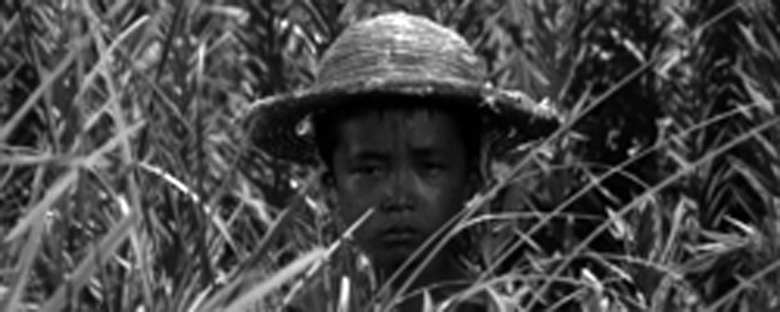Reviews
Otoshiana
Hiroshi Teshigahara
Japan, 1962
Credits
Review by Matt Bailey
Posted on 26 March 2005
Source Masters of Cinema/Eureka! DVD
There have been many teams of filmmakers throughout film history that have resulted in fruitful and repeated collaborations. Apart from the many actor-director teams that have been discussed elsewhere on this site, there are director-composer teams like Alfred Hitchcock and Bernard Herrmann, director-editor teams like Martin Scorsese and Thelma Schoonmaker, even director-cinematographer-production designer-composer-editor teams like David Cronenberg, Peter Suschitzky, Carol Spier, Howard Shore, and Ronald Sanders. Though credit is often given to the directors of these teams for anything positive that results from the collaboration, it is clear that the director values the contributions of each member of the team and that the director feels he would not be creating his best work without them.
One of the most successful collaborative teams in Japanese film was the combination of director Hiroshi Teshigahara, screenwriter Kôbô Abe, composer Toru Takemitsu, and cinematographer Hiroshi Segawa. The three films these four crafted—Pitfall, Woman in the Dunes, and The Face of Another—plus a fourth—The Ruined Map—with cinematographer Akira Uehara replacing Segawa, stand among the most original, unforgettable films of the era.
Pitfall, the first product of this collaboration, is an outgrowth of the documentary filmmaking Teshigahara had been working in for the decade prior to tackling fictive narrative filmmaking. The film, part social-realist portrait of the dying coal-mining industry, part ghost story, was termed a “documentary fantasy” by Teshigahara—a way of looking at a social problem through the filter of myth and folklore. In the film, a mysterious man in a white suit arranges strange coincidences and commits murders that have the result of bringing on a crisis among miners’ unions.
As with many of Teshigahara’s later films, Pitfall begins matter-of-factly, rooted in a realism that allows the audience to define for themselves that parameters of where they believe the story will go. Then, with great ease and often with a single shot, Teshigahara slides the film over into a kind of surrealism. This shift does not betray the realist foundation that came before, but rather builds upon it, emphasizing the strangeness and illogic that often underpins what we believe to be our everyday reality. Because of this, Teshigahara’s films are almost always deeply unsettling, Pitfall being no exception. Though credit must be given to Abe, whose chilling story provided the basis for the film, the film’s effect would be minimal without Teshigahara’s startling visualization of Abe’s ideas, Segawa’s framing and photography of that visualization, and Takemitsu’s moody, minimalist/traditionalist score that ties it all together.
We don’t do comments anymore, but you may contact us here or find us on Twitter or Facebook.



